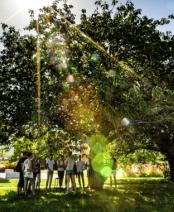Sport, science and performance: Olympic triptych

2024 is an Olympic year. This summer, attention will be riveted on the sportsmen and women: their spectacular performances, the suspense of the competitions, not forgetting the famous medal table. In this final stretch towards the title, the athletes are fine-tuning their preparations with an unexpected ally: physics. Scientists involved in the Sciences2024 program have made cycling, rowing, sailing and swimming - among others - their object of research, with the aim of improving performance. How do training grounds turn into laboratories?
An unexplored field
Christophe Clanet, CNRS Research Director at the Hydrodynamics Laboratory (LadHyX*) of the École Polytechnique and Director of Sciences2024, became interested in sports physics in the late 2000s, without focusing on performance. "We were working on the trajectories of spherical particles in non-Newtonian** media, such as cornstarch. We were intrigued by certain spiral trajectories. We realized that they were linked to particle rotation". One thing led to another, and the researchers made the connection with the rotation of footballs, notably during the free kicks taken by Brazil's Roberto Carlos. The physicist's entry into the field of sports physics was both unexpected and unhoped-for. "With a few exceptions, the field had not been explored by fundamental science".
In this open field, researchers investigate a wide variety of questions, guided by curiosity: why does a badminton shuttlecock have a triangular trajectory (known as the Tartaglia trajectory), whereas a basketball follows a parabola? How does a weightlifter generate force during a bench press? Then, by chance, the LadHyX scientists were approached in 2017 by the team of biathlon champion Martin Fourcade, who were looking to improve wax, i.e. the product applied under the ski soles to optimize glide ahead of the 2018 PyeongChang games. Caroline Cohen, also a LadHyX researcher, sets up the experiment in a refrigerated chamber near the laboratory. The sportsman's team teaches their waxing technique to the researchers, who then begin testing different products.
Was it thanks to this collaboration that Martin Fourcade won three gold medals in Pyeongchang? "We'll never know," replies Christophe Clanet humbly. But, following in the biathlete's footsteps, sports federations see the value of opening their doors to scientists after it was announced in late 2017 that the city of Paris would be hosting the 2024 Games. The Sciences2024 program was therefore launched to enable direct interaction between researchers and Olympic teams. The physics of sport becomes the physics of performance: it's the sportsmen and women's questions that guide the scientific work. "As long as the athletes understand that our objectives are aligned with theirs, the dialogue is fruitful," comments Christophe Clanet. They're constantly on the lookout for ways to optimize their performance, based mainly on how they feel, but also on the numbers. They realize that science has a different view of their discipline, one that complements their own, and that it can bring useful insights."
From measurement to optimization
The first of these is measurement. Poles, bicycle tires, boat hulls, cycling outfits: what's the best material for each discipline and each athlete? Establishing methods to answer these questions enabled the scientists to prove themselves and build trust with the athletes. Next, they were able to go directly into the field with the athletes to determine the laws that link the measurements to each other. Once these laws are understood, they serve as a basis for optimizing performance. "These three phases - measurement, understanding of laws and optimization - form an efficient but lengthy process. Sometimes, we stop at the first stage and the measurement is used directly by the trainer in his exchanges with the athletes to quantify their feelings. But we can also go as far as optimization and propose different approaches to training sessions". Twice a week, the physicist goes to the Saint-Quentin-en-Yvelines national velodrome to talk to French cycling team coaches and athletes like Mathilde Gros, track cycling specialist and individual sprint world champion.
The scientists are thus attempting to make a small contribution to the athletes' quest for perfection in the run-up to the 2024 Olympics. But for Christophe Clanet, this is just the beginning: "We hope that Sciences2024 and, more generally, the research carried out over the last few years for the Paris Games, will be the beginnings of a French research team. This would be a network of scientists who would interact with the sports teams to respond rapidly to their requests. A team that would include not only fundamental scientists, but also psychologists, nutritionists, physiologists and legal experts. This would make research even more fertile."
**The viscosity of a non-Newtonian medium changes according to the stress applied to it. Cornstarch, fluid when mixed gently but viscous when mixed vigorously, is an everyday example.
About
Christophe Clanet is CNRS research director at the Laboratoire d'Hydrodynamique de l'École Polytechnique (LadhyX) and professor at École Polytechnique. His research focuses on physics and sport.
*LadHyX: a joint research unit CNRS, École Polytechnique, Institut Polytechnique de Paris, 91120 Palaiseau, France













